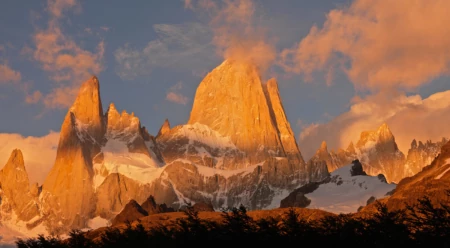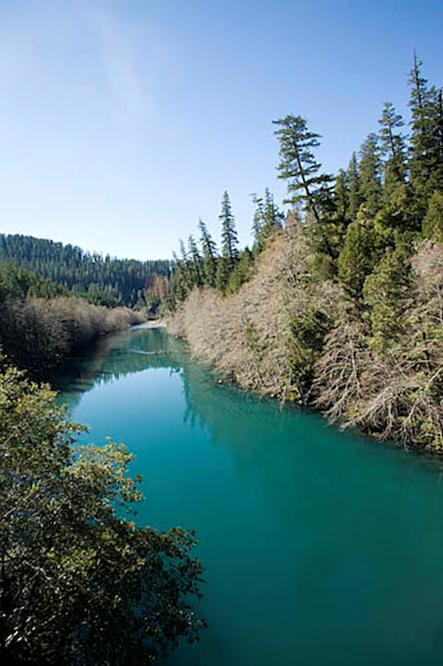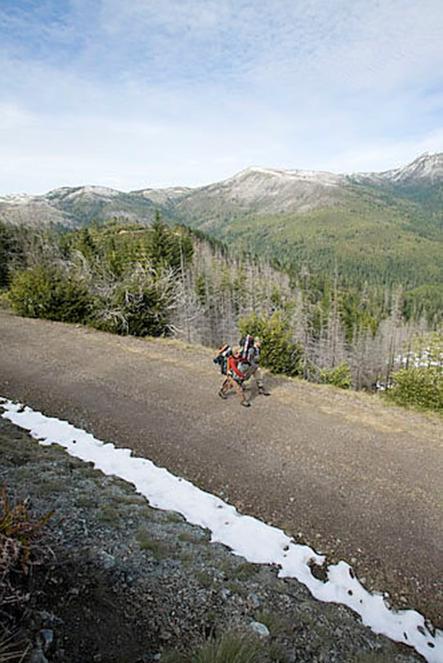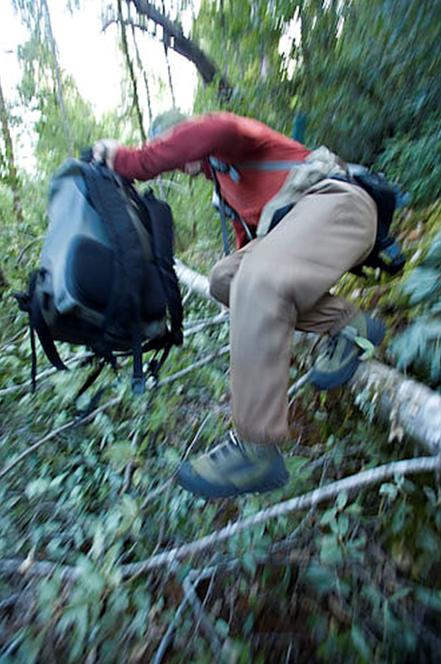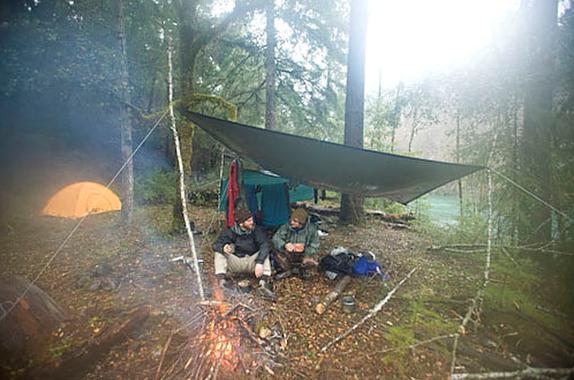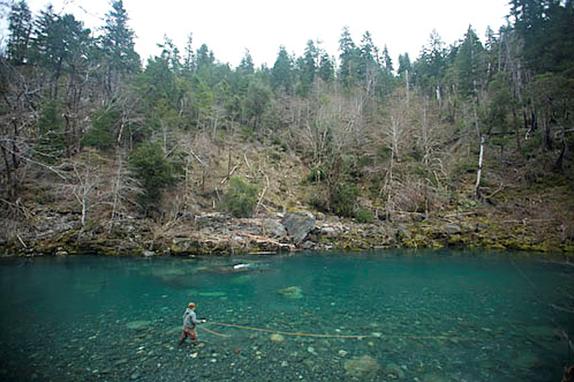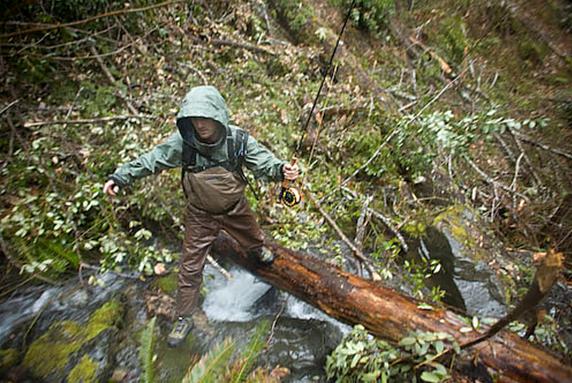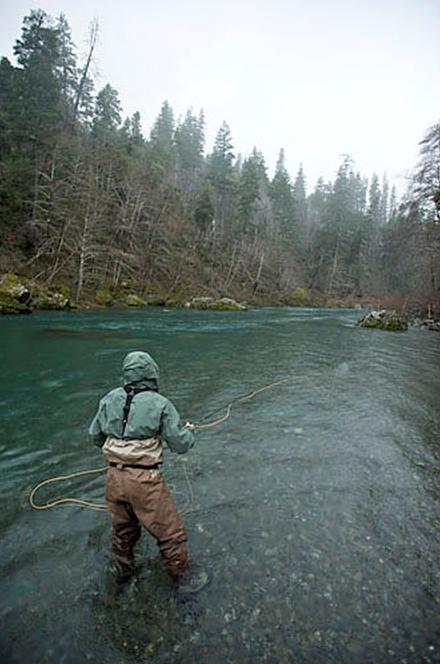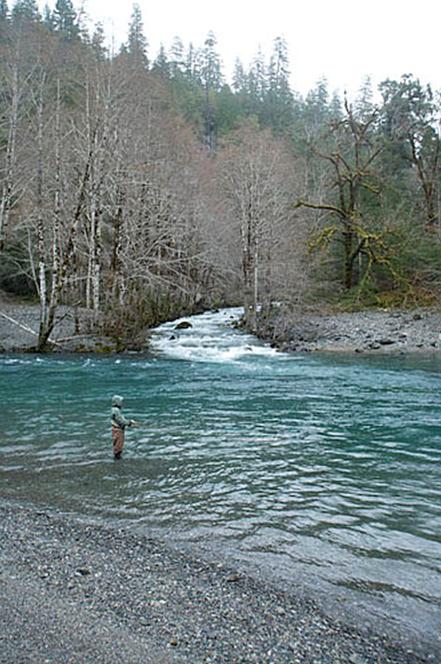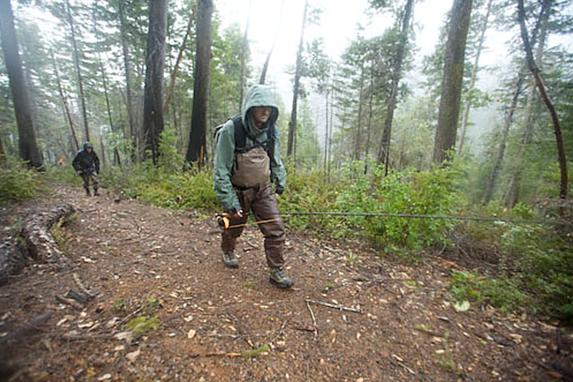Kalmiopsis – Fly Fisherman Mikey Wier Searches for Steelhead in the Oregon Wilderness
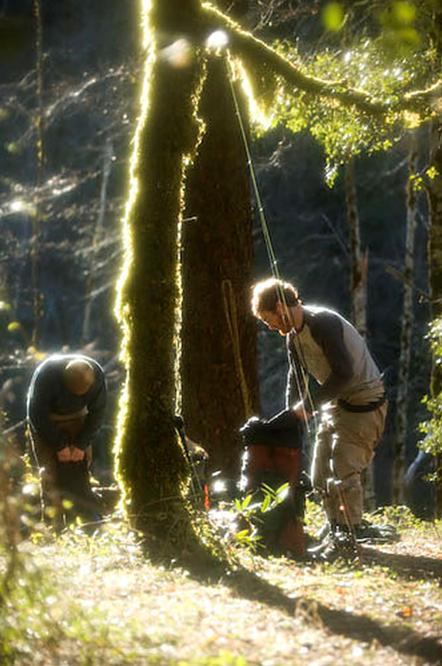
Even if you’re not an angler, I highly recommend taking the time to read this story. It comes from Mikey Wier, a professional snowboarder and fly fishing guide who founded Burl Productions. Mikey’s words are thick with the aura of appreciation that comes from having just returned from a Wilderness area. As you read this tale, there’s a good chance you’ll think back on your last trip into untamed nature and begin to relive the feeling while sitting in front of your computer — a wonderful thing indeed. From Mikey:
It’s 6 am and I’m going over a mental checklist of things I “need” to survive in the wilderness for a few days. I’m always afraid I might forget one of the things that will make me think “oh, crap” later. Headlamp, camera battery, bivy sack, enough food. We’re on the road at 6:30 and by then it’s too late to worry any more. The cold morning air fills my lungs and colors my breath into cloudy vapors. Speeding along in a car, the outside world passes fast. Even while looking out the window, it’s easy to miss the small details, like a bug crawling on a branch, or a salamander swimming in a creek pool. I can’t wait to reach the trail head. I’ve been indoors too much this month and my body longs for the sun and crisp air. It’s the call of the wild.
[All photos by Justin Baillie]
Time in the car passes with catch up conversations between my brother, Eugene and I. Justin Baillie, who made the drive from Tahoe to Southern Oregon with me the day before, was just getting to know Eugene. We shared the research each one of us had done in preparation for the trip. Eugene produced some great photos he had printed off of Goggle Earth. We looked over the topography and bends in the river. It looked passable on paper. Conditions and circumstances had already thwarted us from reaching the headwaters on two different attempts.
On our first attempt at the pass, it rained all day as we hiked thefour miles up hill for the first accent. Eugene and I spent the nightunder just a tarp in some of the hardest rain I had ever seen. I kindof slept for a while in a two-inch puddle of water. In the morning wecould hear the river roaring all the way down at the bottom of thecanyon. We knew we wouldn’t be able to cross the river, let alone thefirst trib. There was no point in going down, so we turned around andhiked back down the pass in the rain. It’s a tricky window of weatherand water conditions you need to be able to penetrate that deep intothe wilderness this time of year. It’s hard when you have to just lookat the calendar and pick a date. It’s especially tough when that windowis usually only a week or two, at most, in February, for the entirecoastal range.
On our second attempt, Eugene and I decided we might be able to tryhiking up the main stem of the river to reach the headwaters. Theproblem with this route is a large, major creek drainage that pusheshard on high water. In ’05, we mapped out a route and gave it a try inthe first week of March. Again, strong rains got the best of us. Wefound the trailhead, but spent the night in the car park under a tarpin the pouring rain. The next morning we made the couple-mile hike tothe river, but it was too high and off color to find fish in a new spotwith fly gear. We barely made the crossing on the first small drainageand figured there was no way we could make the confluence.
By this time around it had become a bit of a personal goal for bothEugene and I to reach this zone. So even after hearing a couplenightmare hiking stories of sleeping in puddles and hiking all day uphill in the rain, Justin still agreed to come along.
On paper, the river conditions looked good. Flows were right, butthe forecast was calling for some precipitation during night two of ourfour-day mission. How much would be our main hurdle. As we turned offthe 101, the estuary and lower river looked great. The sun was shiningand all the plants were green, wet and happy.
As the road turned from pavement to dirt, we all turned our phonesoff at the same time as if part of some ceremony celebrating wildernessand it’s disconnection with the outside world. Not far down the road itbecame apparent that something was very different from the last timeEugene and I had driven the road two years earlier. There were treesdown everywhere. In some places as many as one in five trees were down.There were bay, alder, fir and live canyon oak trees covering parts ofthe road. On the lower areas of the river, where fishing is popular,the trees covering the road had been cut away with chain saws. Wecontinued on, hoping for the best.
After a while the road leaves the river valley and starts heading upthe hill towards the summit of the coastal range. The turn off we werelooking for is about 2,500 feet above sea level. At around 2,000 feetwe started seeing snow. As we crested the small pass that marks theturn off, our hopes were high that we would make it to the trailhead.They were quickly dashed as we came around the corner and found twotrees lying in opposite directions across the front of the turn-offroad. There was also a two-foot drift of snow blocking the road. Aquick assessment of the area determined that there was no way we weregoing to be able to get down that road in a vehicle. We thought aboutturning around, but decided to stick to the mission anyway. It onlyadded an extra three miles to the hike. Only problem being it’s alldownhill on the way there and you know what that means on the way out.We just chalked it up to being what it takes to get a wild wintersteelhead on a fly, and packed up our gear.
Everything is green in the coastal range this time of year. Thesmells of the forest fill my nose. It’s a familiar but unexplainablesmell of trees, shrubs and even the dirt itself. The air was thick withmoisture and as I looked out over the canyon, some wispy clouds filledthe little spaces between the trees. The wind was blowing them in andout of branches like ghosts flying through the treetops. Birds weresinging songs across the forest to each other. A squirrel peered out ofthe trees in curiosity then ran off in a darting jerky gait.
We packed our food and supplies into our bags. Due to the snow andwet conditions, we put on our waders and fishing boots and hit thetrail. After post holing through the snow, climbing over trees anddescending 2,000 feet with four days worth of supplies on our backs, wefinally reached the trailhead and the edge of the wilderness boundary.It’s only a mile from there to where we first hit the river. Once onthe trail, the hiking conditions were even tougher. The downed treeswere hefty obstacles with such heavy packs on our backs. The trail iscut into a hillside, so there is less room to move around the fallentimber than on the road section. Every time we came to a downed tree,we had to balance beam along the trunk, climb over branches, or duckunder a high spot. There were no stretches longer than 100 yards at atime with no trees down. Sometimes there would just be one afteranother. It was a tough mile. Still we pressed on in the name ofsteelhead.
Now that we were off the road, out of the people zone and into thewilderness, it started to become apparent that even though the forestseemed devastated, it’s actually working perfectly. The old-growthtrees are still standing. Most of the downed trees were ten inches indiameter or less. The old growth showed signs of a fire that hadhappened in the canyon 10 years earlier. The new growth had beenthriving for a decade in the newly created niche of sun patches left bythe fire. In early January, a storm dropped large amounts of snow downto almost sea level. The high winds that followed knocked down all thetrees that were loaded with the heavy snow. It’s a great way tonaturally thin the forest. The downed trees were providing newnutrients for the previously stripped ground as well as habitat forthousands of forest creatures. The old-growth trees were still standingtall and proud. They watch over the hills as nature provides for them.For us, it was as inhospitable as can be.
The hike soon turned into a strength and endurance test. With everystep it became harder to press on. Thoughts of friends and failedrelationships filled my mind as I kept placing one foot in front of theother. We didn’t talk much at all during the hike. Somehow I find a wayto reach a zone in my head where I try to think about as much stuff aspossible to take my thoughts off what I’m actually doing. Greatattention is needed for every obstacle we encounter but my thoughtskeep me somewhere else. It’s easy to drift off and not let yourself befully encompassed in the moment. Only here it’s not a TV, blinkinglights or music that serves to distract one. It’s the drudgery of myown thoughts.
Only when we stop and my breath slows down enough that the sound ofit leaves my ears and the sounds of my boots and waders and packrubbing on each other dissipate, that the sounds of the forest reallybegin to take my attention. It’s there in that moment that I start tofeel the true freedom of wilderness. I can hear the wind through theleaves. It whispers and talks with words I’m not conditioned to hear. Ihear the sound of the water dancing with the rocks and trapping airinto fleeting bubbles. It too is speaking and I try to listen. Animalstalk back and forth. Birds, squirrels, and insects all chime in atdifferent times. They are all having conversations that seem likerandom chirps and whistles to me. I try to really take the time to justbe quiet and listen. It’s like learning a new language. I long to knowwhat they are all saying. It just takes time to know all the words. Thefarther I am from the distracting sounds of people and our equipment,the more I feel like I’m starting to hear what nature is trying to say.I feel the most at peace when I know I’m in a place that is unaffectedby the hands of man, where the natural process still flows. I can feelits power and it makes me contemplate my place in nature.
My moment of profound bliss and introspective contemplation isquickly shattered by my brother reminding us of the reality that it’sgetting dark and it’s going to be cold, so we should start setting up acamp and gathering some wood for a fire. We’ve only just reached themain stem of the river. After some scouting, we decide to camp on thefar side of a feeder creek. The crossing takes some concentration andthe aid of a sturdy branch. The water is waist deep and flowing prettyswift. It’s hard to balance on the slippery rocks with such a heavypack. We set up our camp on a flat bluff overlooking the confluence ofthe creek and the main stem. There’s some flat ground surrounded by afew small fir trees and the remains of an old fire ring. A huge oldlive canyon oak tree hangs over the campsite from the hillside above.Everything is covered in moss. I ask if we can camp on the gravel in aclearing in hope of getting some morning sun. Eugene insists this sitewill be better if it starts raining hard because we can set up tarpsbetween the trees.
The first thing I notice as I approach the river is a set of beartracks in an otherwise untouched strip of sand. Some movement catchesmy eye and I focus on a rough skin newt. He’s moving so slow it’salmost tedious to watch. He blends almost perfect with the color of therotting sticks he’s crawling near. I might have stepped on him if Ihadn’t bent down to look at the bear’s prints. I was glad our pathcrossed and I bid him good day.
My first good look at the river and I’m stoked. There is a lot ofwater in the river this time of year, but the water is pretty clear andI can see the bottom in places I determined to be at least eight feetdeep. A gravel bar has built up where the creek pours into the mainstem. It breaks the current well and looks to be a good lay for apassing steelhead. I gather sticks for the fire as quickly as possible,hoping to get a few casts in before dark.
Catching a wild, winter run, pacific coast steelhead on a fly isbecoming a harder proposition every year. Some have compared it to alightning strike, others to finding a gold nugget. You have a betterchance to get one if you go to one of the rivers that have a hatcheryprogram. But to me, it’s just not the same experience. In the systemswhere there is no hatchery to supplement the runs, the fish have torely on the health of the headwaters. Many factors can come into playwith these systems and how they affect fish returns. Erosion is one ofthe biggest problems. Logging, road building and mining are some of thebiggest contributors to erosion. In dam-controlled systems, thereservoir catches most of the sediment and it slowly fills the lake.The river below maintains a steady flow with clean gravel but the fishcan only go as far as the dam, missing out sometimes on hundreds ofmiles of otherwise useful spawning habitat and potential fly water. Innon-controlled systems the sediment affects the fish and their spawninghabitat daily. It’s a sensitive relationship between nature and man,and over time the fish are losing. The fish have many hurtles to dealwith while on their journey in the ocean, and now it’s becoming tougherto find the good conditions that wild steelhead and salmon need tospawn. Headwaters are an important factor in wild fish reproduction anda good way to determine the health of a system. The time it takes ariver to clear up after a rainstorm is a good sign of a cleanheadwaters system. That’s why we picked this particular river. Itsheadwaters flow completely out of roadless wilderness. The river clearsup quicker than most other rivers on the coast and, in the upperstretches, is small enough to cover with a fly rod.
To me, the wild winter steelhead is like a precious gem. Thatsilvery slab has more draw than a chunk of platinum. I’d hike up hillsand camp in the rain just to see one. Catching one ethically, on flygear, and getting to touch it, is one of the greatest feelings onearth. Catching one on a fly is a hard trick to play on a fish that isfor the most part, not interested in eating. Winter fish aren’t likesummers that stay in the river for a while and need to feed to keep uptheir energy. Winter steelies come in, do their thing and are on theirway back to the rich feeding grounds of the ocean in a matter of days.In a system like this you’re lucky to even cross paths with one. Evenif you do see a fish, it certainly doesn’t mean your going to catch it.After peering at the river and making a few casts at the confluence, Iwent to bed that night optimistic that it might happen on this trip.
A sliver of morning light peered through the trees and touched myface. I awoke to the sounds of the forest in all its morning glory. Itwasn’t hard to get up when the possibility of a fish waited. There werea few small clouds in the sky, but it looked as if it was going to be agreat day. We all decided to hike up river deeper into the wildernesstowards the confluence of the two major creeks that formed the mainriver. The river sits in a canyon that is pretty steep on both sides.It’s lined with big boulders and trees. There’s no trail at all. Everyrock is trying to twist your ankle. Every fallen tree is trying to makeyou trip or slip. Most of the rocks on the bank are covered in brightgreen mosses of different lengths and textures. There are small creeksand seeps pouring into the river off the hillsides. The ecosystem ispeaceful, majestic and, most importantly, intact. Everything from thatpart of the river up is natural, wild and unaffected by the hands ofman. In the small sand beaches between the boulders there were mountainlion, bear, otter, raccoon and deer tracks.
Much of the river here is rapids and not great holding water forfish. We had to hike a good 3/4 of a mile before we came to the firstlong stretch of slower water. There, in the shallow tail out of a longrun, I spotted the first fish. As Justin and Eugene showed up, Ipointed it out. The water was very clear. It was hard to tell exactlyhow big the fish was, but I could tell he was pretty small by wintersteelhead standards. He looked to be about five pounds or so. I triedto position myself upstream and make a cast. The river was lined withoverhanging branches and there was only one small place where I couldeven make a roll cast through an opening in the branches. I strippedout the right amount of line and made a good cast. As soon as the linestarted to drift down towards the fish, he split off like a rocket intodeeper water and disappeared. Over the next mile or so, we spottedseveral more fish and took turns making shots at them, all with thesame result. Then we came to a huge cliff face and had to hike way upinto the forest, over all the fallen trees and then back down again tothe river.
Finally we came to a beautiful pool with a nice long gravel tailout. There in the gravel was a female steeling sitting on a fresh dugred. As we sat quietly and watched, a very large male became visiblesitting about 15 to 20 feet back off the red. After a few minutes twosmaller males became visible as well. Soon they started making attemptsto get into the red and rub up on the female. Each time the larger malewould chase them away, sometimes biting them on the tail or flexing hismouth at them. We watched this dance continue for several minutes whileI filmed the fish. After watching for a while we figured this might beour best shot. It was a good bet that in this situation, swinging a flybehind the red might get one of the challengers to bite and potentiallydo the mating pair a favor. I stripped out my line and again made agood cast well upstream. As soon as my line hit the water all four fishshot off like rockets. It was incredible how spooked they were. Theydon’t see any people up there at all. It’s uncanny how they sensedanger from just the slight splash of a fly line. I tried a few moreHail Mary casts into the deepness of the pool, but to no avail. We onlyhad a matter of minutes to spend trying to fish at each pool. The hikewe had set ourselves up for was long and we didn’t want to get stuckout after dark. We had to reach a trail still another mile up river andthe light was waning.
Eventually we reached the pool where a trail that was severalhundred yards up off the river, on the canyon wall, dipped back downnear the river. This pool was distinguishable by a large creek thatflowed in on the opposite side of the river. There in the shallowwater, over a gravel bar, we spotted two more fish. They were sittingnear motionless. Both were suspended a few inches off the bottom andslowly wagging their tails in the soft current. It was Justin’s turn tohave a shot. He stripped out his line and made a good cast well upstream. As his green line drifted down near the fish, they too shot offlike rockets. At that same moment, it started to rain. It was a sinkingending to a hard day. We found the trial and started the long hikethrough the forest back towards our camp. It was almost as hard ashiking near the river. The downed trees made it a challenge. As therain fell on my head, I tried to just keep placing one foot in front ofthe other, my thoughts turned back to the fish. It seemed like all theelements were working against us. With the heavy rain, I knew that wasprobably our last shot at fishing.
It rained hard all night and in the morning the river was rushinghard and off color. We decided to stay anyway and spent the followingmorning exploring down river. After noon, I hiked far up river to whereI had seen the first couple fish the day before. The river was a wholedifferent beast this day. It was dark and fast and scary. Our windowfor fishing had closed.
The next morning we packed up camp and started the trudge home. Aswe hiked back up the hill, again my thoughts turned back to the fish.At first I was upset that I didn’t get to catch one. Then I realizedhow lucky I was to have had the chance to see those fish in theirnative habitat doing what they have been doing for thousands of years.Wilderness is more valuable than any possession I own. I felt soblessed to see them in this environment. Just being there was enoughfor me. As population grows and climate changes, there is going to bean increasing strain on what remains of the habitat needed for thesefish to live and thrive. As fish populations dwindle, they will becomean icon of wilderness. Steelhead will become a symbol of a healthy andfunctioning aquatic ecosystem. In my opinion, they should be morevaluable than gold, platinum or oil. They should be placed in front ofmines, roads, timber sales and this year’s fiscal earnings. Water isone of the main elements that form our existence. Most of our body ismade of it. If we don’t drink clean water almost everyday, we will die.If we can’t take care of the fresh water river systems that supportwild steelhead then we are not working as good stewards of this planet.If we let wild steelhead fade out, we won’t be far behind.
Story: Mikey Wier
Photos: Justin Baillie
Here’s a trailer for SOULFISH, Mikey’s latest movie. It’s available for purchase from the Burl Productions Web site.
[With thanks to Bill and the Patagonia Fly Fishing team.]
